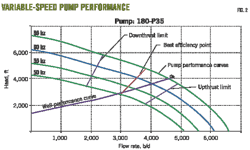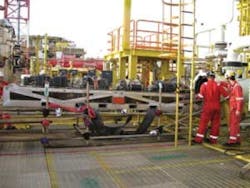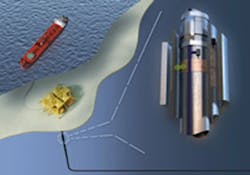GDF Suez's wholly owned gas transmission system operator, GRTgaz, completed its first project with GE Oil & Gas' New MagneScan in-line inspection system, a next-generation magnetic flux leakage device allowing operators to map pipelines as small as 6-in. OD while also inspecting for metal loss and geometry features.
GRTgaz successfully completed its advanced MFL inspection in spring 2009 on a 6-in., 24-mile line in Normandy, France. Built in 1965 northwest of Paris, the pipeline is part of GRTgaz's 32,000-km gas pipeline system in France.
The new system is the first able to inspect pipelines—of varying diameters and sharp bends —for multiple types of features in a single run. The system records the position of: dents, ovalities, and bends; internal and external pitting and general corrosion on the pipe body; metal loss in the vicinity of welds; and metal loss associated with dents and under casings.
The system is designed to detect and locate areas of metal loss in both liquid and gas pipelines ≥5% WT with 90% probability and in practice can detect even smaller metal losses. Sizing accuracy is ±8% at 80% certainty. Full specification can be achieved up to a maximum tool speed of 11 mph, with an operating temperature of –4° to 100° F., up to a maximum pressure of 2,175 psia. The 6-in. diameter version of the tool is 4.5 ft long and can negotiate 1.5 nominal diameter-radius back-to-back bends.
The new system includes 216 low noise Hall-effect sensors in 72 tracks, taking readings on axial, radial, and transverse vectors every 2 mm. This new 3-D configuration covers 100% of the pipe circumference and optimizes defect-sizing accuracy for width, length, and depth.
The system simultaneously maps the pipeline and checks it for corrosion, with high resolution MFL sensors delivering high-quality data to both identify and plot metal loss and perform geographic information systems analysis. It also uses 24 high-resolution caliper sensors to detect and profile dents for accurate assessment of severity.
The tool uses a set of secondary sensors to discriminate between internal and external metal loss. Odometer wheels log distance traveled, while an internal pendulum records the tool's orientation in the pipeline, and a time-based marker system logs its time of passage.
Mapping data are integrated with inspection information during the run, reducing post-processing. Improved accuracy means fewer digs for operators following inspection runs, yielding savings and reduced environmental impact.
While GDF Suez's subsidiary and the technology provider originally agreed the project would include a maximum of five runs to gauge, clean, geometrically survey, inspect, and map the pipeline, completion actually took only four runs with gauge, cleaner profile, and the new MFL tool. Inspection took a single pass after initial gauging, cleaning, and running a dummy tool.
All work took place inside the Jan. 19-30 window set by GDF Suez to minimize effects on its storage facility in St. Illiers. The project also maintained strict compliance with the European Union's ATEX safety requirements, covering operations in potentially explosive atmospheres.
The technology provider delivered the full inspection report to GDF Suez within an agreed 8-week time frame. The new system allows pipeline operators to choose the level of analysis of data they wish to review upon completion of inspection and allows them to come back to the technology provider later with additional requirements for more in-depth analysis leading to remediation plans.
The service determines immediate and future integrity needs by gauging criticality of identified features and developing a corresponding response schedule, focusing short-term repairs on sites of immediate risk and determining intervals for re-inspection and long-term remediation. During a re-inspection the system would assess corrosion growth and the effectiveness of remediation.
To aid data analysts in improving characterization of complex (interactive or axial) corrosion defects, the new technology presents visually powerful data derived from three magnetic fields—axial, radial, transverse. Combining these data sets achieves enhanced defect sizing specifications and improved probability of identification (Figs. 1-2).
Other deployments
In addition to GRTgaz, both Sarpom—ExxonMobil's affiliate refinery and pipelines company in Italy—and Jayhawk Pipeline, a Midwestern US operator, deployed the new MFL technology in first-quarter 2009.
The Sarpom inspection took place on a 6-in. OD, jet-fuel pipeline spanning almost 20.5 miles, from Trecate to Malpensa intercontinental airport. The line was last inspected in 2003. Sarpom operates a network of 720 miles of liquid pipelines in Italy.
The technology provider sought to detect corrosion, dents, and bends, as well as acquire mapping coordinates. Successful inspection took just 4 hr and 45 min, with field support provided by TECMA Pipeline Services.
Inspection of the seamless steel pipeline, partially built in the early 1960s, had three priorities: reduced disruption of operations; a small system arrangement due to space restrictions at the airport; and better corrosion assessment than offered by previously available technology. Sarpom also remarked it had been waiting for credible, 6-in. OD mapping capability.
The first New MagneScan inspection completed in North America occurred on four sections of 6-in. OD refined products pipeline between Kansas and Iowa, spanning a total length of 227.5 miles and operated by Jayhawk Pipeline LLC, a fully owned subsidiary of National Cooperative Refinery Association (Figs. 3-4).
Technicians prepare to launch the tool into one of the Jayhawk products pipeline segments (Fig. 4).
NCRA operates an 85,000-b/d in McPherson, Kansas, as well the products line running from the refinery to Council Bluffs, Iowa, and inspected by the new MFL system.
The four 6-in. OD Jayhawk Pipeline segments measured 49, 60, 58, and 60.5 miles, respectively, and each run was completed in less than 24 hr in standard configuration. Low product speed inside the line required run-time at the upper specification of the tool's battery life.
The New MagneScan system launched at the International Pipeline Conference in Calgary, September 2008. Since December 2008, it has completed inspections in 6, 8, and 10-in. pipelines carrying crude oil, diesel, condensate, jet fuel, and natural gas in Australia, Canada, France, Italy, UK, and US. Numerous inspections are already scheduled for the remainder of 2009.
The author







